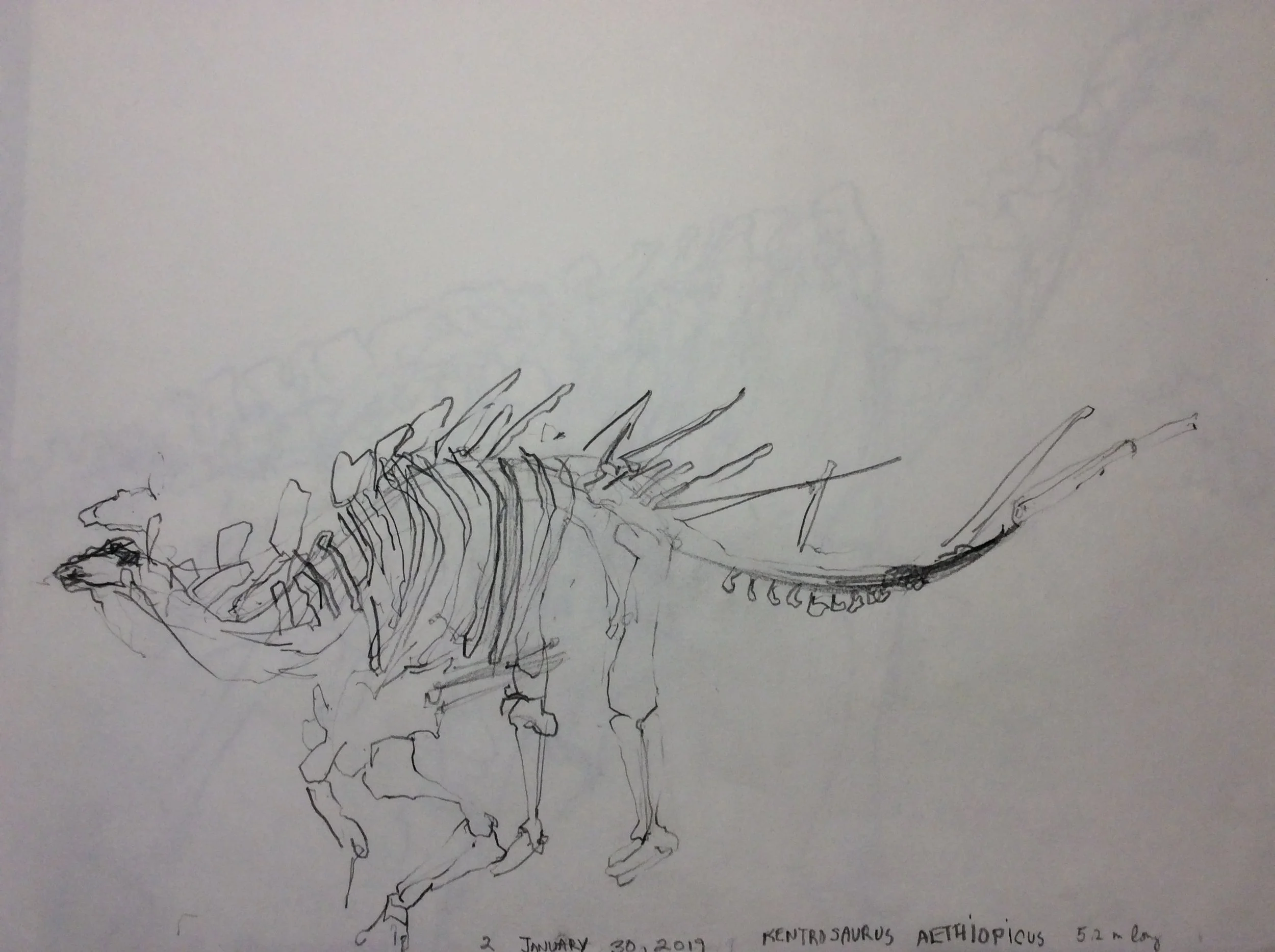Drawing of dinosaur skeleton (by the artist) at Natural History Museum, Berlin Copyright Carolyn Prescott
In thinking about seeing, what I called “extreme seeing” (Seeing, Remembering, Imagining—see below) as well as the seeing associated with memory and reverie, I soon come to my own case of disrupted seeing. Twenty years ago I began to experience a neurological disorder, dystonia, that causes an involuntary squeezing of the muscles of the eyelids. Eventually spreading to the lower face, neck, and shoulders, it caused various hindrances in eating, speaking and walking, but above all, seeing became unreliable. I walked into poles or doors left ajar, knocked glasses off the table. It was not easy to look skyward, so I was focused involuntarily on the near and middle ground, stealing upward glances for a second or two at a time. My timing and judgement of distance in things where those factors matter—from filling a glass with water to stopping the car in traffic—were untrustworthy. My ability to read or to make steady eye contact with others was compromised. The spasms were intermittently and partially brought under control through topical injections but remained present in some form, ever distracting, tiring, disabling. In the last three years, through a combination of movement modalities, my condition has improved. I don’t expect to drive a car again, and family photos attest to a continuing difficulty in keeping my eyes open, but my condition has notably improved.
Dystonia has affected my ability to see, yet counterintuitively perhaps, in the last two decades, the activities that have been among the most calming to the hyperactive nerves around my eyes have been drawing and painting. Admittedly, my seeing was inconstant; it was hard to judge at times when the brush would actually make contact with the paper. It was not possible to have precise control. When I drew a person on the bus or train, my eyes sometimes squeezed shut almost as often as they remained open. I was aware of the gaps, knew I was approximating, inventing, often relying on the hand and not the eye.
The scholar David Rosand has described the way in which a line in drawing becomes a line in space “whose path is clearly controlled by the habits of the trained hand.” The haptic sense I had developed as an art student—the illusion of touching the subject and trusting the reactive motion of my own hand—aided me in creating a line in space. Rosand speaks even of “the haptic ambition of the drawing hand, the repeated attempt to reach the object, to secure it for the grasp.” Whether guided by steady vision or by faultier and more intermittent eyesight, and whether or not it is undertaken for any purpose of rendering—drawing always does involve a haptic exploration and invention and is a function of gesture as much as of vision.
In my case, the very attempt to tame my darting, irregular vision with line was somehow soothing; the line could bring the world around me into line, I might have said, and in turn, the line was freed from mere perception. Again, Rosand identifies the “exploratory possibility of a line that [gives] it purpose; its extension into the world [makes] visible vectors of force and energies otherwise unperceivable by the eye. Line made the world imaginable.” “To draw a line,” says Rosand, “is to extend oneself into the world, to know it, and to recognize one’s self.”
I thought of this recently while drawing the dinosaur skeletons at the natural history museum here in Berlin. I was feeling an urgency to draw from life but wanted to avoid familiar subjects with associated preconceptions or habitual motions. With a definite excitement about taking on so large a form (and appreciation for the return of my ability to look up, to see above eye level), I set my drawing pad on my lap in the great hall of the museum.
The skeletons are indeed so large that it is exhilarating to even contemplate them. In addition to the overall form, which seems determined to extend beyond any single sheet of drawing paper, there is a wealth of detail in the articulation of joints and protruding backbones, in cavities and spines. Yet I found myself constantly referring to and moving with the whole structure, even while struggling to apprehend various sockets and appendages. And somehow ever present was a feeling about the great scientific endeavor to reconstruct these creatures that came before us, to understand how they evolved. Moreover, I even had the admittedly grandiose notion that I had joined that effort to make sense of what is found, of what can be seen. It was a wonderful day, full of discovery. And that is surely one of the key elements of drawing: the curiosity we can bring to it, the desire to discover and invent form and to know the world and place ourselves in it.
— Carolyn Prescott
